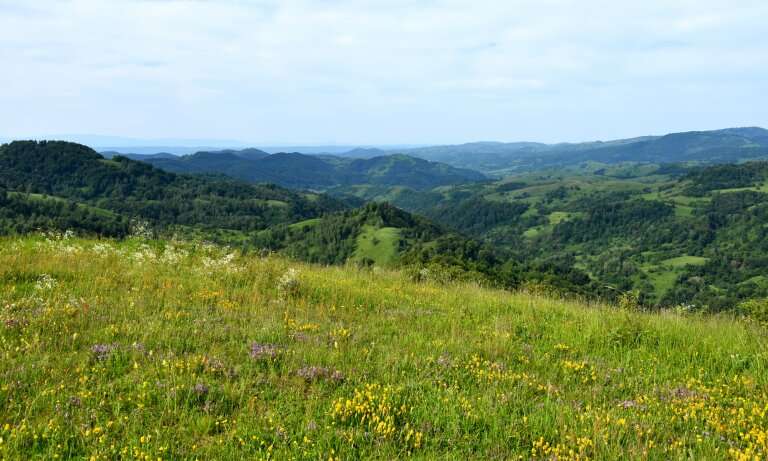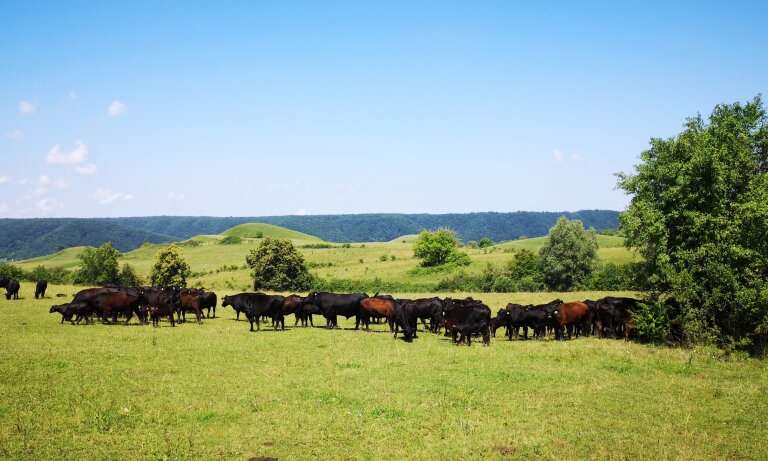Cattle grazing supports biodiversity in Romania

Blocking out the seemingly endless rain, cold and dark of midwinter is no mean feat, but picture this: it's early summer, the days are growing longer, the earth is warming underfoot and meadows are humming with life. Fit to bursting with plants, insects, birds and small mammals, these wildflower havens are a sensory overload. Vibrant yellows, pinks and purples nestle among the fresh greens while the meadow orchestra buzzes, twitters and snuffles its summertime song.
Wildflower-rich grasslands offer us more than inspirational backdrops and daisy chains, though. Flowers attract pollinators foraging for their next nectar fix, permanent plant cover protects soil stability and enhances the land's capacity to retain and store water, helping to reduce flood risk, and altogether the ecosystems lock up significant amounts of carbon.
Many of these wildflower meadows would not exist without people who, over millennia, shaped the landscape through traditional farming practices including livestock grazing and regular cutting for hay.
These diverse, semi-natural grasslands are now globally threatened, however. The culture shift from low-intensity to industrial-scale agricultural management and the increasing use of chemical pesticides and fertilizers are two of the main threats facing these habitats worldwide. The United Kingdom's wildflower meadows have now almost entirely disappeared—97% have been lost within the last century. Pressure is also mounting on wildflower habitat across the rest of Europe, where—alongside the primary threat of intensifying agriculture—afforestation and land abandonment also contribute to the degradation of once-diverse grassland systems. In a few special areas, however, wildflower havens not only remain—they flourish.
One of these refuges is the Târnava Mare area in southern Transylvania, where centuries of traditional land management have shaped a biodiverse and dynamic mosaic of old-growth woodland, wildflower-rich pastures and meadows and small areas of farmed land, supporting over 1,000 plant and 600 butterfly and moth species and representing some of Europe's most extensive semi-natural lowland grassland. Since 2004, Fundaţia ADEPT, an Anglo-Romanian NGO with which Fauna & Flora International (FFI) has been a partner for over 10 years, has worked to conserve the ecological and cultural uniqueness of this landscape.

Historically, dairy cattle grazed these pastures, but industry uncertainty and low economic returns led many farmers to switch to sheep farming. The once species-rich grassland of Angofa valley suffered greatly where sheep had overgrazed, leaving an eroded habitat taken over by invasive weeds and with dwindling floristic diversity.
To prevent further deterioration, ADEPT purchased 200 hectares of land within the Angofa valley, grant-aided by FFI's Halcyon Land & Sea Fund, supported by Arcadia—a charitable fund of Lisbet Rausing and Peter Baldwin—and FFI's wider supporter network. The plan was to reinstate cattle grazing—a much more sympathetic way to manage grasslands than sheep farming, as cattle graze less closely and selectively than sheep and their trampling habits open up coarse vegetation and leave tussocks of longer grasses which benefit insects and small mammals.
Generous donations from individual UK supporters and support from FFI enabled the purchase of a 60-strong herd of Aberdeen Angus beef cattle and, since their arrival at Angofa in March 2018, once degraded pastures are already showing encouraging signs of regeneration. Floristic diversity is on the rebound and it is hoped that with this habitat recovery, birds such as corncrake, butterflies including the large blue and a whole host of other insects and small mammals will once again thrive here.
Now a healthy and established herd, the cattle are not only helping to restore the land—they also offer a viable, profit-making economic model which can be scaled across other Transylvanian communities and the wider Carpathian region.
The Angofa farm's profits from 2019 will be reinvested in the farm and will support ADEPT's other core conservation activities. The purchase and sensitive management of this land has prevented the loss of an important refuge for biodiversity and we look forward to further supporting ADEPT as they continue to protect the nature-rich farming landscapes of Transylvania.
No comments:
Post a Comment